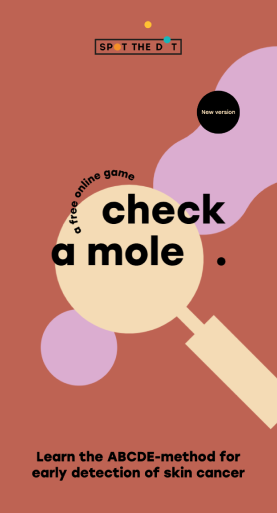Melanoma can affect every body
Everyone is at risk of getting melanoma
The number of Canadians being diagnosed with melanoma has more than tripled in the past 30 years
Melanoma is a serious type of skin cancer that can happen in men and women regardless of age, sex, or race. It is one of the most common cancer types in those between 15 to 49 years old.
Your chance of getting melanoma might be higher if you*:
- Live in southern regions or coastal cities in Canada
- Have fair, sun-sensitive skin; skin that burns rather than tans; freckles
- Have more than 50 moles
- Have close family members who have had melanoma
- Use tanning beds
- Have a history of severe sunburns
* Please note that this list is not exhaustive and there are other risk factors for melanoma. If you have any questions about melanoma risk factors, be sure to ask your doctor.
Melanoma can
look different on different bodies
It can affect different body parts
Melanoma can happen anywhere on the skin. Women typically get it on their back or lower legs. Men usually get it on their back, neck, and head. Other sites include the arms, scalp or face.
It can appear differently in people of colour
It’s harder to spot melanoma in people with darker skin tones. In people with darker skin tones, melanoma can sometimes be seen on the palms of their hands, under their nails, or soles of their feet.
Learn more about how melanoma appears differently on your skin at Melanoma Canada.
Get up close and personal with your skin
Your skin is the largest organ in your body
It protects you, and you should protect it. Your skin protects you against outside factors, like the sun, high temperatures, and germs. Practice SkintimacyTM (i.e., having a close, intimate relationship with your skin) to help you spot possible signs and symptoms of melanoma. For those hard-to-see places, get a loved one to help you. Small actions, like checking your body, can have a big impact.
Look out for your loved ones
Generally, earlier diagnosis of melanoma leads to better outcomes. In a 2020 survey,* only 51% of Canadians said that they were knowledgeable about melanoma. Talk to those close to you and Practice SkintimacyTM with loved ones by checking for signs of melanoma on their skin.

Checking your skin regularly can help you spot something of concern. I do this with my husband, but you can ask a friend, family member, or anyone you feel comfortable with really. The ABCDE rule is a good guide to help you know what to look for and when you should speak to your doctor.
Karen
melanoma patient
Learn the ABCDEs
of melanoma
Practice SkintimacyTM to help you find a mole
that stands out
Check your skin for signs of melanoma at home. You’ll need a:
- Ruler
- Mirror
- Comb
- Friend or a loved one (to look in the hard-to-see places)
A malignant mole may look unusual. Follow melanoma’s ABCDEs to know what to look for.

Asymmetry
Is the shape of one half of the mole different than the other half?

Borders
Are the edges of the mole irregular, blurred, or ragged?

Colour
Is the mole an unusual colour (different shades of tan, brown, black, sometimes with blue, gray, red, pink, or white) or more than one colour or shade?

Diameter
Is the mole bigger than 6 mm from edge to edge?

Evolution
Has the mole changed over time? Has it become itchy, scaly, or does it bleed?

How well do you
know your ABCDEs?
Test your knowledge of some
of the signs of melanoma
Disclaimers and References:
Photographs of skin used throughout the site do not depict melanoma. Speak to a healthcare practitioner if you are concerned about any of your moles.
* The survey was conducted by Leger et al, in March 2020 in collaboration with Novartis Pharmaceuticals Canada Inc. and Save Your Skin Foundation.
- Melanoma Canada. Available at: https://melanomacanada.ca/. Last accessed May 2, 2024.
- Canadian Dermatology Association. Melanoma. Available at: https://dermatology.ca/public-patients/skin/melanoma/. Last accessed May 2, 2024.
- Conte S et al. Population-based study detailing cutaneous melanoma incidence and mortality trends in Canada. Frontiers in Medicine. 2022; 9(830254). https://doi.org/10.3389/fmed.2022.830254
- Save Your Skin Foundation. Skin cancer in people of colour. Available at: https://saveyourskin.ca/skin-cancer-in-people-of-colour/. Last accessed May 2, 2024.
- Canadian Cancer Society. Melanoma. Available at: https://cancer.ca/en/cancer-information/cancer-types/melanoma-skin. Last accessed May 2, 2024.
- Canadian Cancer Society. Survival statistics for melanoma skin cancer. Available at: https://cancer.ca/en/cancer-information/cancer-types/melanoma-skin/prognosis-and-survival/survival-statistics. Last accessed May 2, 2024.
- Save Your Skin Foundation. We need to step up our knowledge about melanoma. Available at: https://sauvetapeau.ca/download/https-saveyourskin-ca-wp-content-uploads-survey-results-highlights_sysf-website_may-27-2020_final-en-pdf/. Last accessed May 2, 2024.
- Canadian Cancer Society. Finding skin cancer early. Available at: https://cancer.ca/en/cancer-information/cancer-types/melanoma-skin/finding-cancer-early. Last accessed May 2, 2024.
